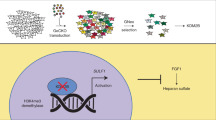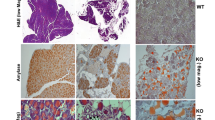Abstract
Mammalian heparanase degrades heparan sulfate, the most prominent polysaccharide of the extracellular matrix. Causal involvement of heparanase in tumor progression is well documented. Little is known, however, about mechanisms that regulate heparanase gene expression. Mutational inactivation of tumor suppressor p53 is the most frequent genetic alteration in human tumors. p53 is a transcription factor that regulates a wide variety of cellular promoters. In this study, we demonstrate that wild-type (wt) p53 binds to heparanase promoter and inhibits its activity, whereas mutant p53 variants failed to exert an inhibitory effect. Moreover, p53-H175R mutant even activated heparanase promoter activity. Elimination or inhibition of p53 in several cell types resulted in a significant increase in heparanase gene expression and enzymatic activity. Trichostatin A abolished the inhibitory effect of wt p53, suggesting the involvement of histone deacetylation in negative regulation of the heparanase promoter. Altogether, our results indicate that the heparanase gene is regulated by p53 under normal conditions, while mutational inactivation of p53 during cancer development leads to induction of heparanase expression, providing a possible explanation for the frequent increase of heparanase levels observed in the course of tumorigenesis.
This is a preview of subscription content, access via your institution
Access options
Subscribe to this journal
Receive 50 print issues and online access
$259.00 per year
only $5.18 per issue
Buy this article
- Purchase on Springer Link
- Instant access to full article PDF
Prices may be subject to local taxes which are calculated during checkout





Similar content being viewed by others
References
Allison SJ, Milner J . (2004). Carcinogenesis 25: 1551–1557.
Bernfield M, Gotte M, Park PW, Reizes O, Fitzgerald ML, Lincecum J et al. (1999). Annu Rev Biochem 68: 729–777.
Bhowmick NA, Moses HL . (2005). Curr Opin Genet Dev 15: 97–101.
de Mestre AM, Khachigian LM, Santiago FS, Staykova MA, Hulett MD . (2003). J Biol Chem 278: 50377–50385.
El-Assal ON, Yamanoi A, Ono T, Kohno H, Nagasue N . (2001). Clin Cancer Res 7: 1299–1305.
el-Deiry WS, Kern SE, Pietenpol JA, Kinzler KW, Vogelstein B . (1992). Nat Genet 1: 45–49.
el-Deiry WS, Tokino T, Velculescu VE, Levy DB, Parsons R, Trent JM et al. (1993). Cell 75: 817–825.
Elkin M, Cohen I, Zcharia E, Orgel A, Guatta-Rangini Z, Peretz T et al. (2003). Cancer Res 63: 8821–8826.
Farmer G, Colgan J, Nakatani Y, Manley JL, Prives C . (1996). Mol Cell Biol 16: 4295–4304.
Friedmann Y, Vlodavsky I, Aingorn H, Aviv A, Peretz T, Pecker I et al. (2000). Am J Pathol 157: 1167–1175.
Gohji K, Hirano H, Okamoto M, Kitazawa S, Toyoshima M, Dong J et al. (2001). Int J Cancer 95: 295–301.
Goldshmidt O, Zcharia E, Aingorn H, Guatta-Rangini Z, Atzmon R, Michal I et al. (2001). J Biol Chem 276: 29178–29187.
Gurova KV, Roklin OW, Krivokrysenko VI, Chumakov PM, Cohen MB, Feinstein E et al. (2002). Oncogene 21: 153–157.
Haupt S, Haupt Y . (2004). Cell Cycle 3: 912–916.
Ho J, Benchimol S . (2003). Cell Death Differ 10: 404–408.
Hulett MD, Freeman C, Hamdorf BJ, Baker RT, Harris MJ, Parish CR . (1999). Nat Med 5: 803–809.
Jiang P, Kumar A, Parrillo JE, Dempsey LA, Platt JL, Prinz RA et al. (2002). J Biol Chem 277: 8989–8998.
Kalluri R . (2003). Nat Rev Cancer 3: 422–433.
Kiaris H, Chatzistamou I, Trimis G, Frangou-Plemmenou M, Pafiti-Kondi A, Kalofoutis A . (2005). Cancer Res 65: 1627–1630.
Koliopanos A, Friess H, Kleeff J, Shi X, Liao Q, Pecker I et al. (2001). Cancer Res 61: 4655–4659.
Kosir MA, Wang W, Zukowski KL, Tromp G, Barber J . (1999). J Surg Res 81: 42–47.
Kussie PH, Hulmes JD, Ludwig DL, Patel S, Navarro EC, Seddon AP et al. (1999). Biochem Biophys Res Commun 261: 183–187.
Lee KC, Crowe AJ, Barton MC . (1999). Mol Cell Biol 19: 1279–1288.
Lu WC, Liu YN, Kang BB, Chen JH . (2003). Oncogene 22: 919–923.
Marchetti D, Li J, Shen R . (2000). Cancer Res 60: 4767–4770.
Maxhimer JB, Somenek M, Rao G, Pesce CE, Baldwin Jr D, Gattuso P et al. (2005). Diabetes 54: 2172–2178.
Michalovitz D, Halevy O, Oren M . (1990). Cell 62: 671–680.
Milyavsky M, Shats I, Erez N, Tang X, Senderovich S, Meerson A et al. (2003). Cancer Res 63: 7147–7157.
Mirza A, McGuirk M, Hockenberry TN, Wu Q, Ashar H, Black S et al. (2002). Oncogene 21: 2613–2622.
Miyashita T, Reed JC . (1995). Cell 80: 293–299.
Murphy M, Ahn J, Walker KK, Hoffman WH, Evans RM, Levine AJ et al. (1999). Genes Dev 13: 2490–2501.
Nadav L, Eldor A, Yacoby-Zeevi O, Zamir E, Pecker I, Ilan N et al. (2002). J Cell Sci 115: 2179–2187.
O'Doherty U, Swiggard WJ, Malim MH . (2000). J Virol 74: 10074–10080.
Ogishima T, Shiina H, Breault JE, Tabatabai L, Bassett WW, Enokida H et al. (2005a). Clin Cancer Res 11: 1028–1036.
Ogishima T, Shiina H, Breault JE, Terashima M, Honda S, Enokida H et al. (2005b). Oncogene 24: 6765–6772.
Okamoto K, Beach D . (1994). EMBO J 13: 4816–4822.
Ossovskaya VS, Mazo IA, Chernov MV, Chernova OB, Strezoska Z, Kondratov R et al. (1996). Proc Natl Acad Sci USA 93: 10309–10314.
Rohloff J, Zinke J, Schoppmeyer K, Tannapfel A, Witzigmann H, Mossner J et al. (2002). Br J Cancer 86: 1270–1275.
Seto E, Usheva A, Zambetti GP, Momand J, Horikoshi N, Weinmann R et al. (1992). Proc Natl Acad Sci USA 89: 12028–12032.
Shteper PJ, Zcharia E, Ashhab Y, Peretz T, Vlodavsky I, Ben-Yehuda D . (2003). Oncogene 22: 7737–7749.
Sionov RV, Haupt Y . (1999). Oncogene 18: 6145–6157.
Subbaramaiah K, Altorki N, Chung WJ, Mestre JR, Sampat A, Dannenberg AJ . (1999). J Biol Chem 274: 10911–10915.
Sun Y, Wenger L, Rutter JL, Brinckerhoff CE, Cheung HS . (1999). J Biol Chem 274: 11535–11540.
Timpl R . (1996). Curr Opin Cell Biol 8: 618–624.
Toyoshima M, Nakajima M . (1999). J Biol Chem 274: 24153–24160.
Vlodavsky I, Friedmann Y . (2001). J Clin Invest 108: 341–347.
Vlodavsky I, Friedmann Y, Elkin M, Aingorn H, Atzmon R, Ishai-Michaeli R et al. (1999). Nat Med 5: 793–802.
Vlodavsky I, Fuks Z, Bar-Ner M, Ariav Y, Schirrmacher V . (1983). Cancer Res 43: 2704–2711.
Vogelstein B, Lane D, Levine AJ . (2000). Nature 408: 307–310.
Vousden KH, Lu X . (2002). Nat Rev Cancer 2: 594–604.
Weisz L, Zalcenstein A, Stambolsky P, Cohen Y, Goldfinger N, Oren M et al. (2004). Cancer Res 64: 8318–8327.
Yoshida M, Kijima M, Akita M, Beppu T . (1990). J Biol Chem 265: 17174–17179.
Zcharia E, Metzger S, Chajek-Shaul T, Friedmann Y, Pappo O, Aviv A et al. (2001). J Mammary Gland Biol Neoplasia 6: 311–322.
Zcharia E, Philp D, Edovitsky E, Aingorn H, Metzger S, Kleinman HK et al. (2005). Am J Pathol 166: 999–1008.
Zilfou JT, Hoffman WH, Sank M, George DL, Murphy M . (2001). Mol Cell Biol 21: 3974–3985.
Acknowledgements
We thank Mrs Irit Cohen (Hadassah-University Medical Center, Jerusalem) for help with the ChIP assay, Professors Moshe Oren (Weizmann Institute of Science, Israel), Karen Vousden (Beaston Institute, UK), D Trono, (University of Geneva, Switzerland) and Reuven Agami (The Netherland Cancer Institute) for plasmids. This study was supported by a Postdoctoral Fellowship from the Israel Cancer Research Fund, by a Scholarship from the Women's Group of the Mexican Friends of the Hebrew University (awarded to LB) and by grants from the US Army (Award #W81XWH-04-1-0235), the Israel Science Foundation (Grant 532/02), the Israel Cancer Association, the Prostate Cancer Foundation, and by United States Public Service Grant RO1 CA 106456 from NCI, National Institutes of Health.
Author information
Authors and Affiliations
Corresponding author
Rights and permissions
About this article
Cite this article
Baraz, L., Haupt, Y., Elkin, M. et al. Tumor suppressor p53 regulates heparanase gene expression. Oncogene 25, 3939–3947 (2006). https://doi.org/10.1038/sj.onc.1209425
Received:
Revised:
Accepted:
Published:
Issue Date:
DOI: https://doi.org/10.1038/sj.onc.1209425
Keywords
This article is cited by
-
Upregulation of ERK-EGR1-heparanase axis by HDAC inhibitors provides targets for rational therapeutic intervention in synovial sarcoma
Journal of Experimental & Clinical Cancer Research (2021)
-
Heparanase modulation by Wingless/INT (Wnt)
Molecular Biology Reports (2021)
-
Heparanase and the hallmarks of cancer
Journal of Translational Medicine (2020)
-
Heparan sulfate proteoglycans undergo differential expression alterations in left sided colorectal cancer, depending on their metastatic character
BMC Cancer (2018)
-
Heparanase: roles in cell survival, extracellular matrix remodelling and the development of kidney disease
Nature Reviews Nephrology (2017)



